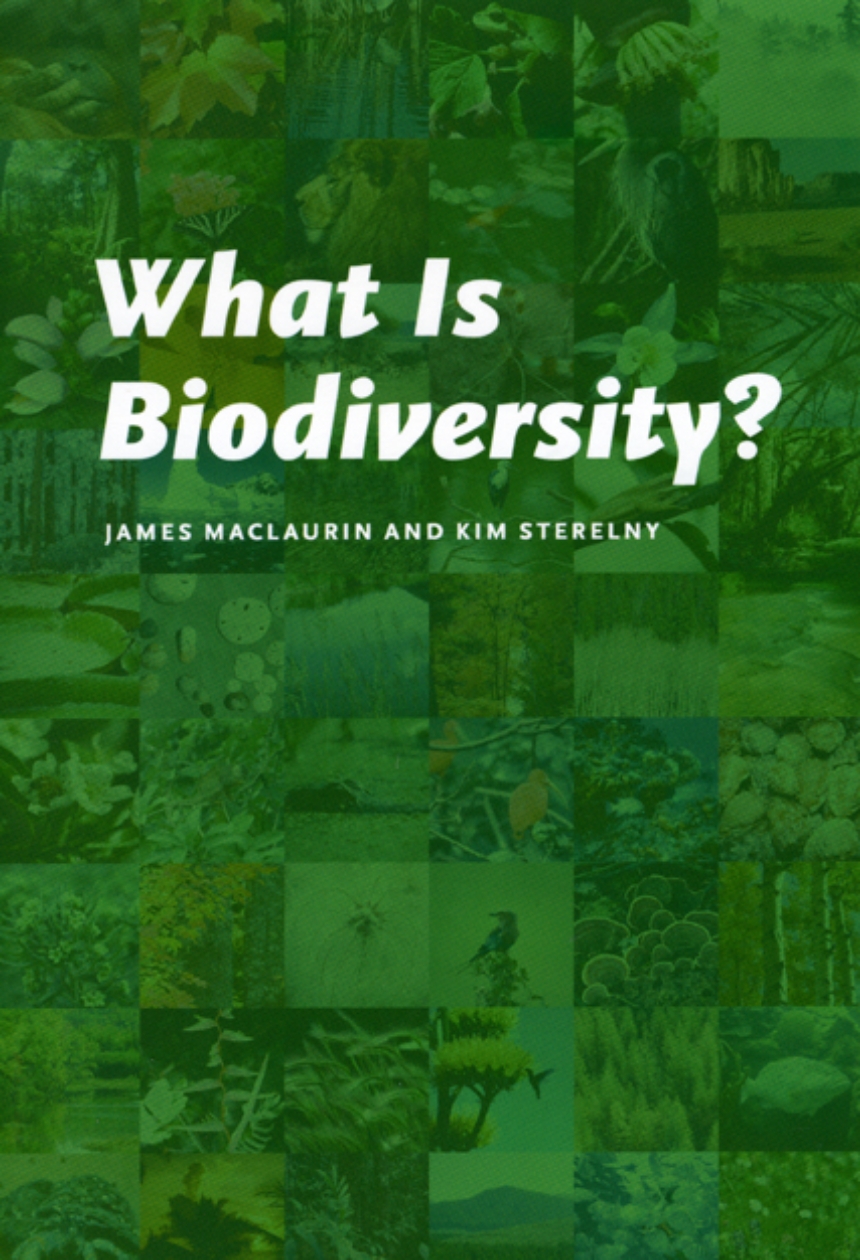What Is Biodiversity?
In the life sciences, there is wide-ranging debate about biodiversity. While nearly everyone is in favor of biodiversity and its conservation, methods for its assessment vary enormously. So what exactly is biodiversity? Most theoretical work on the subject assumes it has something to do with species richness—with the number of species in a particular region—but in reality, it is much more than that. Arguing that we cannot make rational decisions about what it is to be protected without knowing what biodiversity is, James Maclaurin and Kim Sterelny offer in What Is Biodiversity? a theoretical and conceptual exploration of the biological world and how diversity is valued.
Here, Maclaurin and Sterelny explore not only the origins of the concept of biodiversity, but also how that concept has been shaped by ecology and more recently by conservation biology. They explain the different types of biodiversity important in evolutionary theory, developmental biology, ecology, morphology and taxonomy and conclude that biological heritage is rich in not just one biodiversity but many. Maclaurin and Sterelny also explore the case for the conservation of these biodiversities using option value theory, a tool borrowed from economics.
An erudite, provocative, timely, and creative attempt to answer a fundamental question, What Is Biodiversity? will become a foundational text in the life sciences and studies thereof.
Here, Maclaurin and Sterelny explore not only the origins of the concept of biodiversity, but also how that concept has been shaped by ecology and more recently by conservation biology. They explain the different types of biodiversity important in evolutionary theory, developmental biology, ecology, morphology and taxonomy and conclude that biological heritage is rich in not just one biodiversity but many. Maclaurin and Sterelny also explore the case for the conservation of these biodiversities using option value theory, a tool borrowed from economics.
An erudite, provocative, timely, and creative attempt to answer a fundamental question, What Is Biodiversity? will become a foundational text in the life sciences and studies thereof.
224 pages | 14 halftones, 19 line drawings, 2 tables | 6 x 9 | © 2008
Biological Sciences: Biology--Systematics, Conservation, Ecology, Evolutionary Biology, Natural History
Earth Sciences: Environment
Geography: Environmental Geography
Philosophy: Ethics
Reviews
Table of Contents
Acknowledgments
1 Taxonomy Red in Tooth and Claw
1.1 Biodiversity and “Biodiversity”
1.2 Biodiversity and Biodiversities
1.3 History and Taxonomy
1.4 Diversity as Cause; Diversity as Effect
1.5 Prospectus: The Road Ahead
2 Species: A Modest Proposal
2.1 Introduction
2.2 Species, Species Concepts, and Speciation
2. 3 The Effect of Speciation
2.4 Species and Biodiversity
3 Disparity and Diversity
3.1 The Cone of Increasing Controversy
3.2 How Disparate Was the Cambrian Fauna?
3.3 Fossils in a Molecular World
4 Morphology and Morphological Diversity
4.1 Introduction
4.2 Morphological Diversity
4.3 Biological Possibility Spaces
4.4 The Power of Morphospaces
4.5 Here There Be No Dragons: The Limits of Theoretical Morphology
4.6 Morphological Biodiversity
5 Development and Diversity
5.1 Diversity, Disparity, Plasticity
5.2 The Variety of Developmental Resources
5.3 From Gene Regulation to Modularity
5.4 Modularity in Development and Evolution
5.5 Developmental Biodiversity
6 Explorations in Ecospace
6.1 Ecological Systems
6.2 Communities, Ecosystems, and Ecosystem Functions
6.3 Individualism and Community Regulation
6.4 The Emergent Property Hypothesis
6.5 Boundaries
6.6 The Space of Population Assemblages
7 Conservation Biology: The Measurement Problem
7.1 Introduction
7.2 Counting Taxa
7.3 Measuring Phylogenetic Diversity
7.4 Measuring Genetic Diversity
7.5 Biodiversity Surrogates
8 Conservation Biology: The Evaluation Problem
8.1 Value
8.2 Is Biodiversity Intrinsically Valuable?
8.3 Demand Value
8.4 The Option Value Option
8.5 Applying Option Value: Case 1, Phylogeny
8.6 Applying Option Value: Case 2, Bioprospecting
8.7 Applying Option Value: Case 3, Ecological Option Value
8.8 The Conservation Consequences of Option Value Models
9 Concluding Remarks
9.1 Introduction: The Temptations of a Unified Measure
9.2 The Variety of Diversities
9.3 Should We Conserve Species?
Notes
References
Index
1 Taxonomy Red in Tooth and Claw
1.1 Biodiversity and “Biodiversity”
1.2 Biodiversity and Biodiversities
1.3 History and Taxonomy
1.4 Diversity as Cause; Diversity as Effect
1.5 Prospectus: The Road Ahead
2 Species: A Modest Proposal
2.1 Introduction
2.2 Species, Species Concepts, and Speciation
2. 3 The Effect of Speciation
2.4 Species and Biodiversity
3 Disparity and Diversity
3.1 The Cone of Increasing Controversy
3.2 How Disparate Was the Cambrian Fauna?
3.3 Fossils in a Molecular World
4 Morphology and Morphological Diversity
4.1 Introduction
4.2 Morphological Diversity
4.3 Biological Possibility Spaces
4.4 The Power of Morphospaces
4.5 Here There Be No Dragons: The Limits of Theoretical Morphology
4.6 Morphological Biodiversity
5 Development and Diversity
5.1 Diversity, Disparity, Plasticity
5.2 The Variety of Developmental Resources
5.3 From Gene Regulation to Modularity
5.4 Modularity in Development and Evolution
5.5 Developmental Biodiversity
6 Explorations in Ecospace
6.1 Ecological Systems
6.2 Communities, Ecosystems, and Ecosystem Functions
6.3 Individualism and Community Regulation
6.4 The Emergent Property Hypothesis
6.5 Boundaries
6.6 The Space of Population Assemblages
7 Conservation Biology: The Measurement Problem
7.1 Introduction
7.2 Counting Taxa
7.3 Measuring Phylogenetic Diversity
7.4 Measuring Genetic Diversity
7.5 Biodiversity Surrogates
8 Conservation Biology: The Evaluation Problem
8.1 Value
8.2 Is Biodiversity Intrinsically Valuable?
8.3 Demand Value
8.4 The Option Value Option
8.5 Applying Option Value: Case 1, Phylogeny
8.6 Applying Option Value: Case 2, Bioprospecting
8.7 Applying Option Value: Case 3, Ecological Option Value
8.8 The Conservation Consequences of Option Value Models
9 Concluding Remarks
9.1 Introduction: The Temptations of a Unified Measure
9.2 The Variety of Diversities
9.3 Should We Conserve Species?
Notes
References
Index
